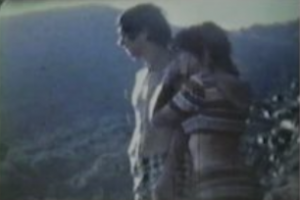
"Era una película que desarrollaba un tema muy propio de la contracultura de la época: la posibilidad de regresar a la naturaleza para vivir una vida al margen de la contaminación y de la vida moderna. Se trataba de una cinta de menos de diez minutos de duración, que contaba una historia breve pero ilustrativa de la naturaleza de los debates entre los jóvenes mexicanos cercanos a la contracultura. [...] La historia de Sergio García hacía una crítica al escapismo hippie, esperanzado por la posibilidad de crear un mundo alterno al de la realidad del capitalismo industrial" (Vázquez Mantecón, 2012).
"It was a film that developed a topic very related to the counterculture of the time: the possibility of going back to nature to live a life away from pollution and the modern life. The film lasted less than 10 minutes, and it told a brief but illustrative story about the nature of the debates between the Mexican youth that was close to the counterculture. [...] The story by Sergio García was a critique of the hippie escapism, hopeful for the possibility of creating an alternate world to the reality of industrial capitalism" (Vázquez Mantecón, 2012).
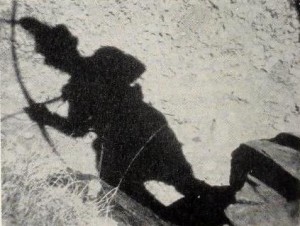
"In The Barrier, Glen H. Turner, Maxim Award winner in 1949 with One Summer Day, shows that the excellence of that production was no happy accident. Although the two films are as different as night and day, both are instinct with the same qualities of creative imagination and true understanding of the movie medium. This year's production, as we understand it, is bi-lingual in its message. On the screen Mr. Turner tells a robust adventure tale, in which a wandering western horseman, attacked by unfriendly Indians, has to fight his way out of their clutches and (even more menacing) over the heart-stopping challenge of a great stone barrier to his freedom. Around this screen action, and carried by the narrative, the producer also draws a frame of universal reference to all of life's challenging struggles. Pictorially, the acting of the horseman is powerful and convincing, while Turner's camera treatment of his adventures creates a spine-chilling sense of danger and drama. Especially effective is the producer's handling of the Indians, whose menacing presence is suggested only — by moving shadows, braceleted brown arms or moccasined stealthy feet." Movie Makers, Dec. 1950, 466.
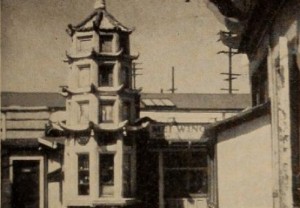
"An idol stolen from a Chinese temple and the efforts of a loyal retainer to recover it provide George Kirstein with a novel springboard for the unfolding of this unusual travel film. Subsequent events carry the principals from New York to Chicago, through the Southwest to Los Angeles and Hollywood, up the coast to San Francisco and finally back to New York for restoration of the idol. Far from hindering the sightseeing sequences, Mr. Kirstein's device enhances the presentation of this material. While the camera handling is satisfying throughout, tighter editing would speed up the pace and heighten dramatic interest." Movie Makers, Dec. 1949, 471.
"Sid gets eaten by a Tyrannosaurus Rex." UCLA Film & Television Archive.
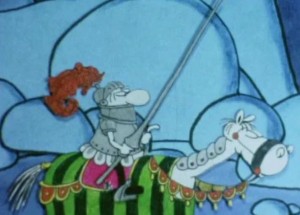
Film de animación que cuenta la anécdota de un caballero que tiene un encuentro casual cuando se dirige a las Cruzadas.
Animated film that tells the story of a knight that has a casual encounter as he travels to the Crusades.
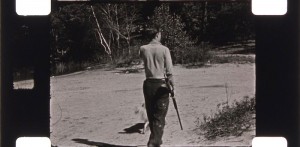
"Hunting, cast of "Boy," played by Winthrop Rolfe, and "Dog," played by Teddy. Boy, walks with Dog through the forested mountainside, gazes at views over the alley, drinks water from a rushing stream, and kneels to shoot at birds." Notes by (NHF) Chris Reed and Chris Castiglia, June 2013
According to the filmmakers, "The scenario was our own—concerning the difficulties confronting a British telegraph company in maintaining communications between Uganda and the Sudan. A story requiring such foreign locale—Africa's desert, veldt and jungle—was written with the object of demonstrating to our audiences the cinema possibilities of our northeastern states" (111).
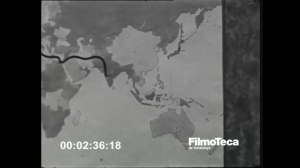
(Catalan): Un explorador vestit de safari recorre el món fent escala a ciutats com Roma, El Caire, Bombai, Nova York i Tànger, fins al seu retorn a Barcelona. En el seu periple entra a un bar de Nova York, visita una barberia i veu com un pidolaire té una màquina registradora. A Camerún veu un mico, un senglar, beu aigua d'un coco, es topa amb un hipopòtam. A Tànger visita la ciutat i els seus habitants, entra a una mesquita i coincideix amb un grup de música i ball. Finalment, a la seva arribada a Barcelona és rebut amb els més grans honors.
Mockumentary that depicts a fictional trip around the world. An explorer travels the world, stopping in cities such as Rome, Cairo, Mumbai, New York and Tangier. During the journey we see him entering a bar in New York, visiting a barber shop and seeing how a beggar has a cash register. In Cameroon, he sees a monkey, a wild boar, and runs into a hippopotamus. He also drinks water from a coconut. In Tangier, he enters a mosque and meets a music and dance group. Finally, upon his arrival to Barcelona, he is received with the greatest honors. All the locations were recreated by the director.
"Begins with a close-up intro of the Davis's in a small boat. One of the girls falls overboard and is saved. A woman drops her jewels overboard. Family disembarks. Finds a clue on a piece of paper. The Family sets out in boat with shovels, saws, axes, etc. Quarrel with another family. Find a deed." oldfilm.org
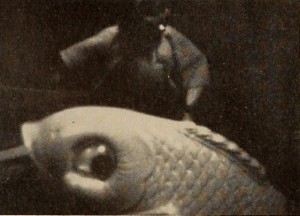
"Neither the lead title nor the unpretentious opening scenes — as a small boy is seen building a crude toy boat — prepares the spectator for the pure enchantment of One Summer Day. For, almost unrealized even as it happens, the film melts with incredible smoothness from live action into animation and make-believe. The toy boat becomes a pirate galleon of old, a flower a maiden in distress and a twig her gallant suitor, as there unfolds a tale of romantic derring-do. Under cover of darkness, the pirates plot to kidnap the lady, whose protector, a humble fisherman, is away at his nets. He returns, only to be bested in the ensuing sword play, yet, undaunted, he still gives chase. With the help of a friendly whale, he overtakes the pirates, frees his lady and, as the galleon goes down in flames, the lovers return to shore, to live happily ever after. Then, as quietly as it all began, we are back at the edge of the sunlit pond. The boy lifts his boat from the water and turns homeward. And yet, through the true magic of the movies, we have entered for a brief moment childhood's enchanted world. Highly imaginative camera handling, technical skill and a keen sense of cinematic values make this an outstanding example of personal filming. The musical accompaniment and sound effects (including the cling-clang-cling of clashing swords) complement the picture perfectly. Glen Turner has added a new dimension to amateur filming with this simple story so superbly told in its brief 350 feet of 8mm. film." Movie Makers, Dec. 1949, 452-453.
Total Pages: 2